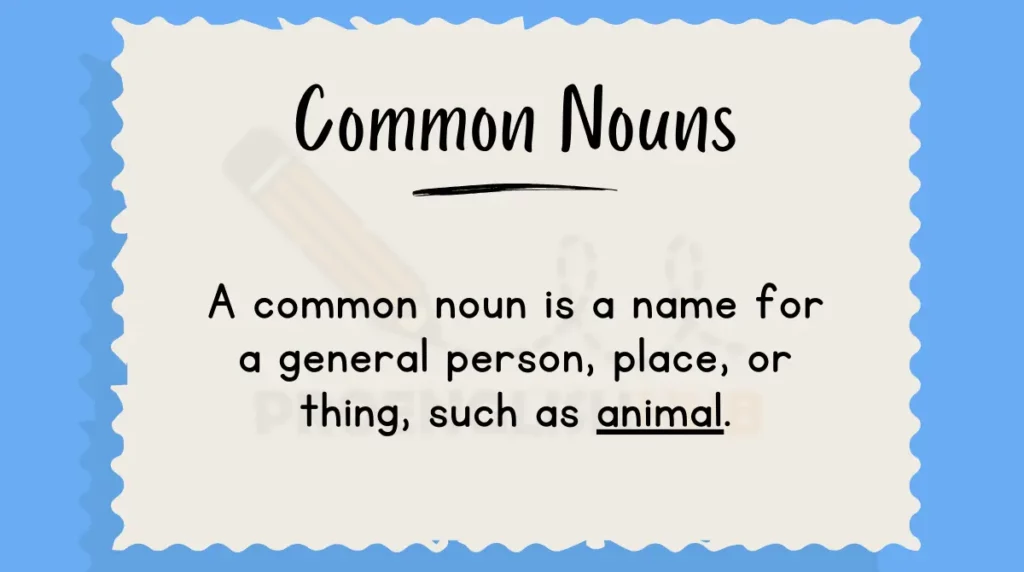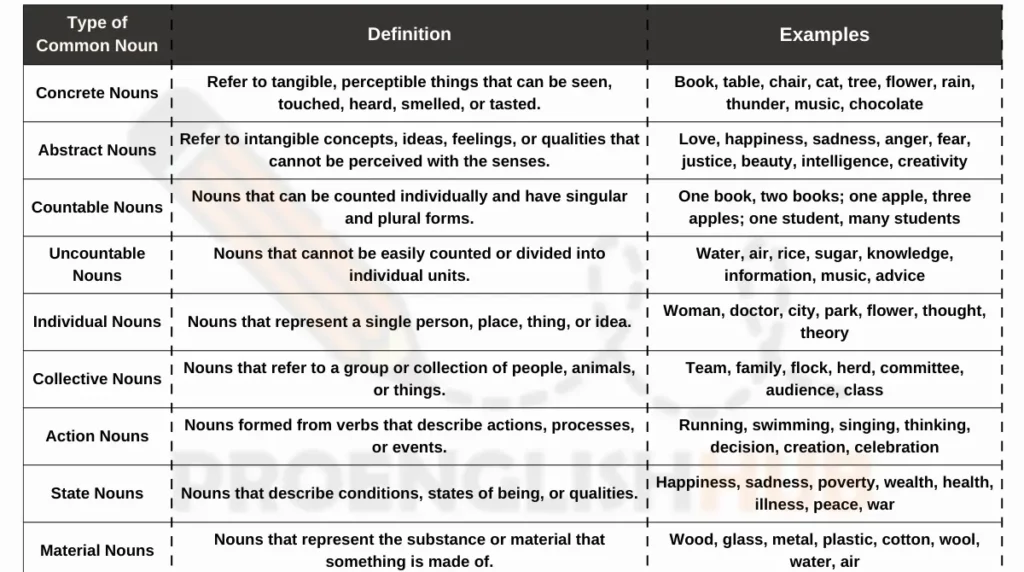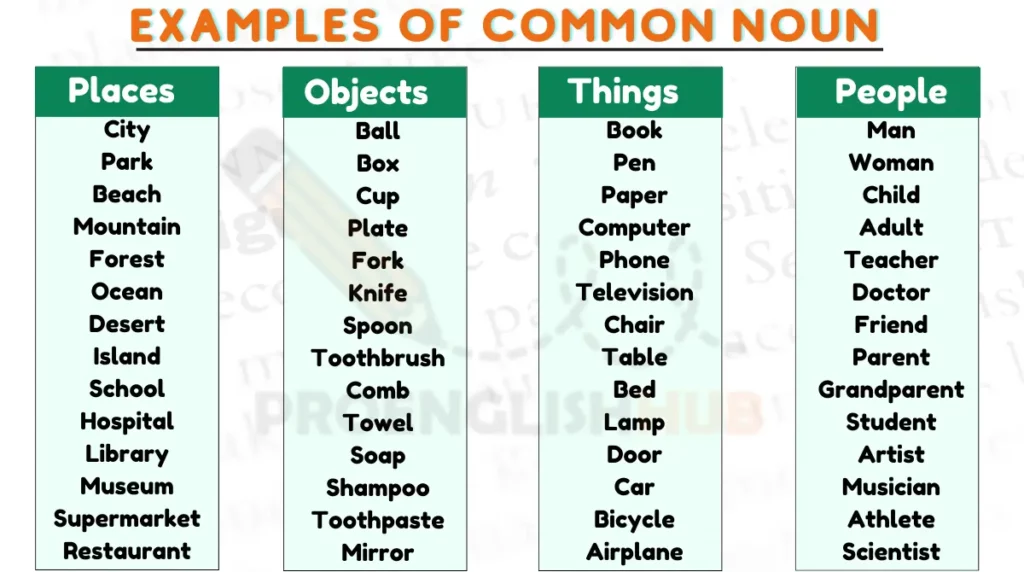Table of Contents
ToggleWhat is Common Noun?
A common noun is a type of noun that is used to identify general people, places, things or ideas. Unlike proper nouns that name specific people or places, common nouns refer to broad categories. For example, “teacher” and “city” are common nouns.

Common nouns lack capitalization unless beginning a sentence and can take both singular and plural forms. For instance, a singular common noun would be “dog” while plural would be “dogs.” Additionally, common nouns express generality rather than a specific person, place or thing.
Types of Common Nouns

1. Concrete Nouns
Description: Refer to tangible, perceptible things that can be seen, touched, heard, smelled, or tasted.
Examples: book, table, chair, cat, tree, flower, rain, thunder, music, chocolate
Further detail
- Can be further divided into animate (living) and inanimate (non-living) nouns.
- Examples of animate concrete nouns: dog, bird, person, child
- Examples of inanimate concrete nouns: rock, pencil, computer, house
2. Abstract Nouns
Description: Refer to intangible concepts, ideas, feelings, or qualities that cannot be perceived with the senses.
Examples: love, happiness, sadness, anger, fear, justice, beauty, intelligence, creativity
Further detail
- Often represent internal states or emotions.
- Can be challenging to define or visualize concretely.
3. Countable Nouns
Description: Nouns that can be counted individually and have singular and plural forms.
Examples: one book, two books; one apple, three apples; one student, many students
Further detail
- Can be used with numbers or quantifiers like “many,” “few,” “several,” etc.
4. Uncountable Nouns
Description: Nouns that cannot be easily counted or divided into individual units.
Examples: water, air, rice, sugar, knowledge, information, music, advice
Further detail
- Often represent substances, masses, or abstract concepts.
- Typically used in singular form without articles (e.g., “I need water,” “We value knowledge”).
- To specify a quantity, use expressions like “a cup of coffee,” “a piece of advice,” etc.
5. Individual Nouns
Description: Nouns that represent a single person, place, thing, or idea.
Examples: woman, doctor, city, park, flower, thought, theory
Further detail
- Refer to distinct entities that can be considered as individual units.
6. Collective Nouns
Description: Nouns that refer to a group or collection of people, animals, or things.
Examples: team, family, flock, herd, committee, audience, class
Further detail
- Treated as singular nouns in most cases, even though they represent multiple individuals (e.g., “The team is playing well”).
7. Action Nouns
Description: Nouns formed from verbs that describe actions, processes, or events.
Examples: running, swimming, singing, thinking, decision, creation, celebration
Further detail
- Often end in -ing, -ment, -tion, or -ance.
- Can function as subjects or objects in sentences.
8. State Nouns
Description: Nouns that describe conditions, states of being, or qualities.
Examples: happiness, sadness, poverty, wealth, health, illness, peace, war
Further detail
- Often express emotions, states of mind, or physical conditions.
9. Material Nouns
Description: Nouns that represent the substance or material that something is made of.
Examples: wood, glass, metal, plastic, cotton, wool, water, air
Further detail
- Often refer to raw materials or substances used in production or manufacturing.
10. Proper Nouns in General Use
Description: Proper nouns that have become so commonly used that they function as common nouns.
Examples: kleenex (for tissue), band-aid (for adhesive bandage), jacuzzi (for hot tub), zipper
Further detail
- Usually start with a capital letter as proper nouns, but can become lowercase when used generically.
Examples Of Common Nouns Based On Different Entities
Here are examples of common nouns based on different entities:

Common Nouns Referring to Human Beings
- Person – e.g., teacher, doctor, friend
- Child – e.g., boy, girl, toddler
- Adult – e.g., man, woman, senior
- Occupation – e.g., engineer, artist, chef
Common Nouns Referring to Animals
- Mammal – e.g., dog, cat, elephant
- Rodent – e.g., mouse, rat, squirrel
- Aquatic Animal – e.g., fish, whale, dolphin
- Wild Animal – e.g., lion, tiger, bear
Common Nouns Referring to Birds
- Bird of Prey – e.g., eagle, hawk, owl
- Waterfowl – e.g., duck, goose, swan
- Songbird – e.g., robin, canary, nightingale
Common Nouns Referring to Insects
- Flying Insect – e.g., butterfly, bee, mosquito
- Crawling Insect – e.g., ant, beetle, spider
Common Nouns Referring to Reptiles
- Snake – e.g., cobra, python, rattlesnake
- Lizard – e.g., gecko, chameleon, iguana
- Turtle – e.g., tortoise, sea turtle
Common Nouns Referring to Places
- City – e.g., New York, Tokyo, Paris
- Country – e.g., Brazil, India, Australia
- Landform – e.g., mountain, valley, beach
- Building – e.g., house, school, hospital
Common Nouns Referring to Things/Objects
- Tool – e.g., hammer, screwdriver, pliers
- Furniture – e.g., table, chair, sofa
- Electronic Device – e.g., computer, smartphone, television
Common Nouns Referring to Ideas
- Concept – e.g., love, happiness, time
- Philosophy – e.g., democracy, freedom, justice
- Feeling – e.g., anger, excitement, curiosity
Usage in Sentences
- The cat is sleeping on the windowsill.
- I have a beautiful flower in my garden.
- The teacher is explaining a new lesson to the students.
- We enjoyed a delicious pizza for dinner.
- The sun is shining brightly in the sky.
- I can hear the sound of a passing car.
- The children are playing with a colorful ball in the park.
- She bought a new book to read over the weekend.
- My favorite color is blue.
- The dog is barking loudly in the backyard.


